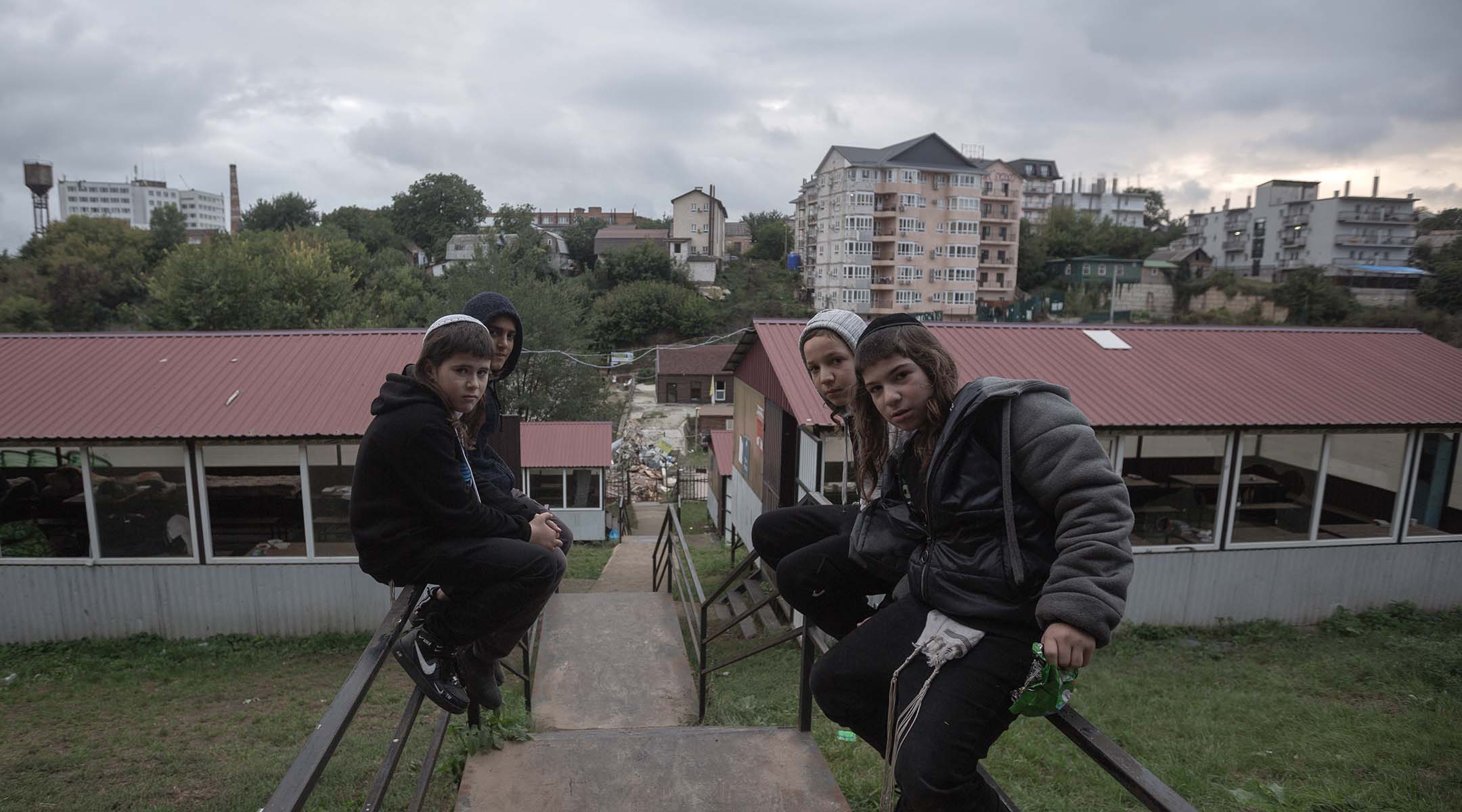 |
Michael Brodsky the anti-Semite ---- NaNaNaNaNaNa
|
Defying Ukraine’s wartime warnings, thousands of Hasidic pilgrims have made it to Uman for Rosh Hashanah
UMAN, Ukraine (JTA)
— As he jogged up a hill in this central Ukrainian town, a Hasidic man
in a black knee-length coat flicked through a pocket prayer book. He was
heading towards the one-story complex built atop a cemetery that houses
the tomb of Rabbi Nachman of Breslov. And he was late for a
post-morning prayer celebration that involved music — including some
klezmer-influenced saxophone — and rhythmic clapping.
It felt like a scene from just about any past Rosh Hashanah season in Uman,
when the town’s Jewish quarter turns into a shtetl of sorts, hosting
thousands of mainly Israeli pilgrims who belong to the Breslov branch of
Hasidism. Rabbi Nachman encouraged his followers to visit his tomb for
the Jewish New Year, and visit they have — in groups of varying size
since his death in 1811, through various periods of 20th and 21st
century upheaval. In 2018, over 40,000 Jews thronged the streets of
Uman.
So far this year, it is estimated
that 2,000 Hasidic pilgrims — overwhelmingly men, although some families
visit as units — are already believed to be here, crowding into shoddy
local apartment and hotel buildings. Some 8,000 more could arrive by the
holiday, which begins at sundown on Sunday.
But this year has presented the
pilgrims with an array of obstacles — all stemming from the ongoing war
that has made Uman a danger zone.
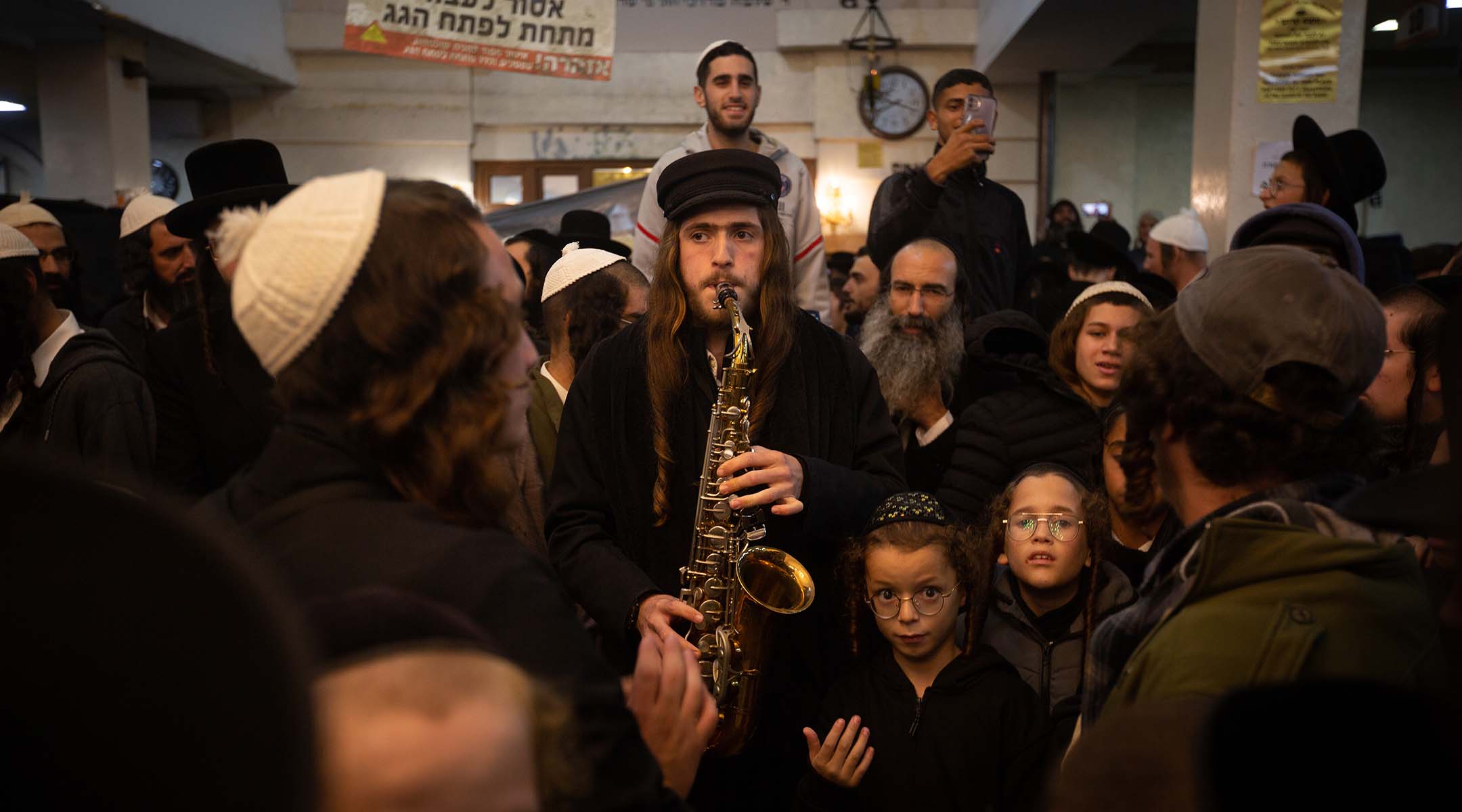
A man plays a saxophone at a gathering in Uman, Sept. 19, 2022.
Ukrainian officials have urged Jewish
pilgrims to not come, warning that any mass gathering in Uman, which
has been struck multiple times since the start of the war, could become a
target for Russian attack. U.S. embassies in Israel and elsewhere put
out a striking warning that urged people who decided to go anyway to “draft a will.”
By now, some areas in the Jewish
quarter seem to have more armed police than Jews. A JTA journalist who
arrived on Monday was only able to move around under the observation of
two heavily armed minders.
“It is clearly not the best time to
come,” Ukraine’s Minister of Culture Oleksandr Tkachenko told the Jewish
Telegraphic Agency. “A better time will come after our victory.”
Nevertheless, when interviewed by the
JTA, some pilgrims preparing to leave for the trip from the heavily
Orthodox town of Monsey, New York, and some of those already in Uman
either nonchalantly laughed at the warnings or responded to them with
righteous indignation. The potential of a missile attack seemed to be a
relative afterthought for most.
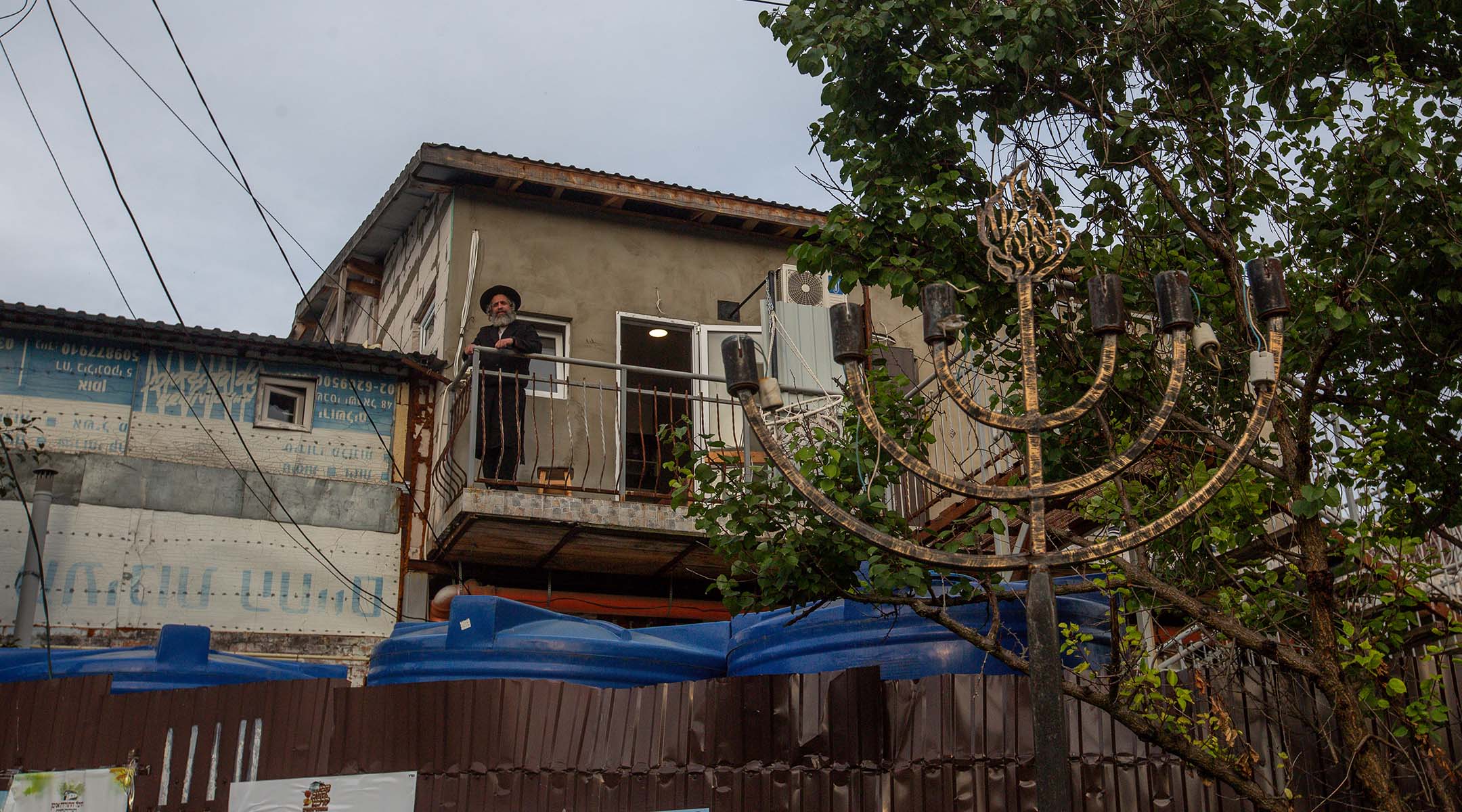
The
town’s apartments and hotels are old, cramped and shoddily built
“My mother was afraid,” said Moe, an
18-year-old from Williamsburg, Brooklyn, who like several others did not
give his last name for privacy concerns. “There was no other option for
me. I was not afraid to come, because everything — my health and my
wealth — depends on me being here at Rosh Hashanah.”
On a recent weekday, outside the
grave complex — which also contains a synagogue and several other rooms —
bearded Israelis in hoodies hung around smoking and sipping tea under a
drizzling rain. When asked whether the potential dangers caused by the
Russian invasion had made them consider skipping Uman this year, there
was bewildered chatter.
“This is my rabbi,” protested Avi
Koller, a 49-year-old Jerusalemite. “It is like when they told Jimi
Hendrix that he was going to die from drugs. Jimi Hendrix replied that
while he could die from drugs, he could also be hit by a bus tomorrow.
We can die from anything.”
Koller, a former rocker who said he found religion late, took another drag on his cigarette.
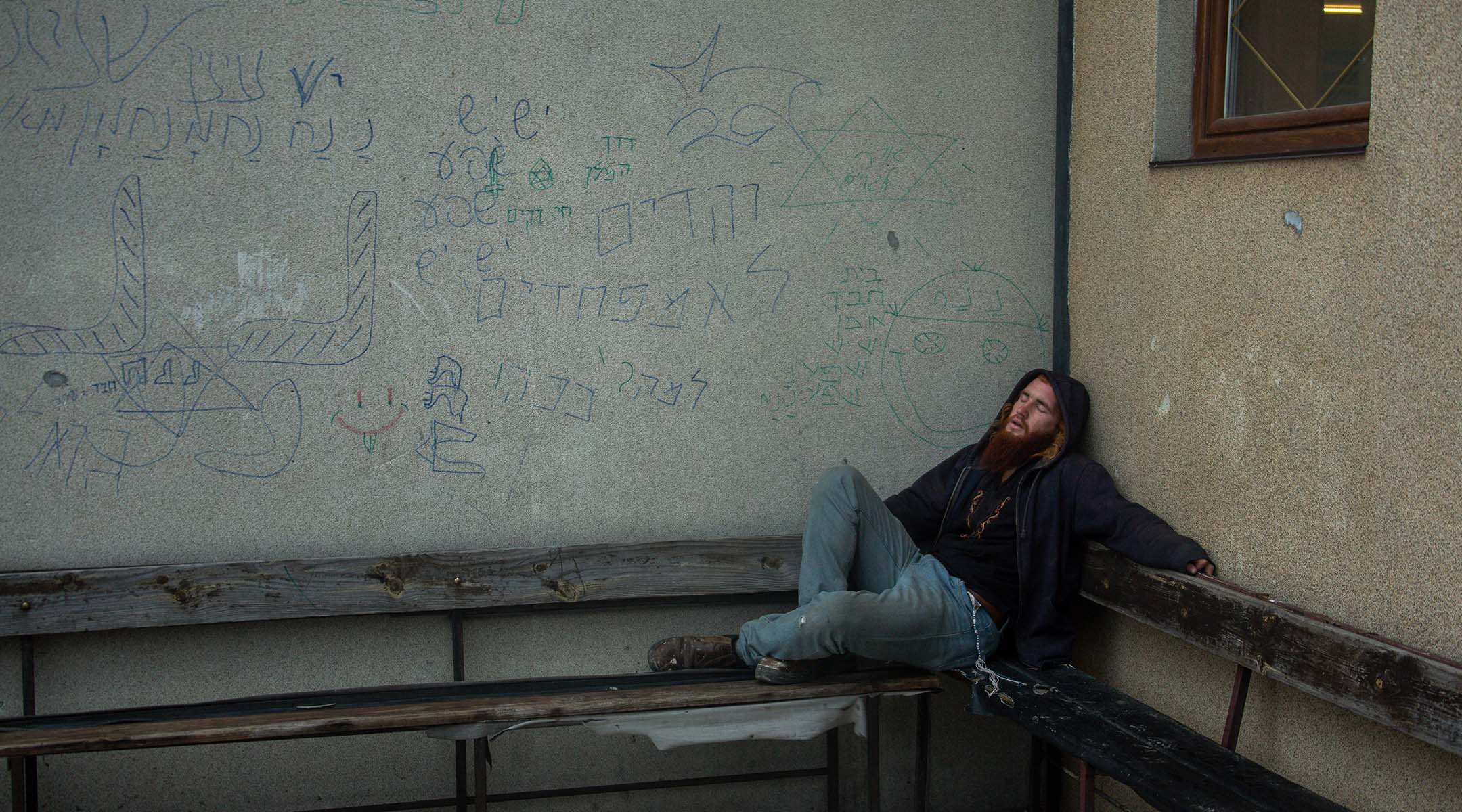
A pilgrim gets a nap in.
“Anyway, do you see any Russian
missiles? Everything is fine here. In the evening, we have our curfew,
from 11 to 5, and that is it,” he said.
But the journey has not been easy for
most this year. The pilgrims, who usually come to Uman via Kyiv, have
had to make other arrangements. Many decided to come days or weeks early
to ensure that they were in Ukraine come what may. Since direct flights
to Ukraine have been canceled, most are flying to Poland, Romania and
Moldova, before hopping in taxis for expensive rides across the border.
Some have stopped for a respite in a western city like Lviv; the journey
from western Ukraine to Uman can then take up to 10 or more hours.
In some Breslov Telegram channels,
which have been abuzz with requests for advice, users continually
comment on an endless stream of photos of Turkish Airlines and El Al
tickets to Chisinau and Bucharest, all being resold at exorbitant rates.
Travel agents offer “once in a lifetime” offers for $1,000 tickets for
flights and transport.
“When the war started, the only
question I was asking myself was how I would get to Uman. All I knew was
that for sure I would have to get here,” said Binyamin, 27, who said
this year is his 20th time spending Rosh Hashanah in Uman. “I came
through Romania. I landed in Bucharest and took an 18-hour taxi ride
here.”
He spent $800 on his flights. “If you come earlier,” he said with a smile, “it is cheaper.”
On Monday, Ukrainian officials said
they would be increasing security checks around Uman and redoubling
efforts to explain the wartime rules — such as a strict curfew and a
restriction on taking photos of military personnel — to pilgrims
arriving from Israel. There is much skepticism on the ground that the
guidance is needed or will even be imparted.
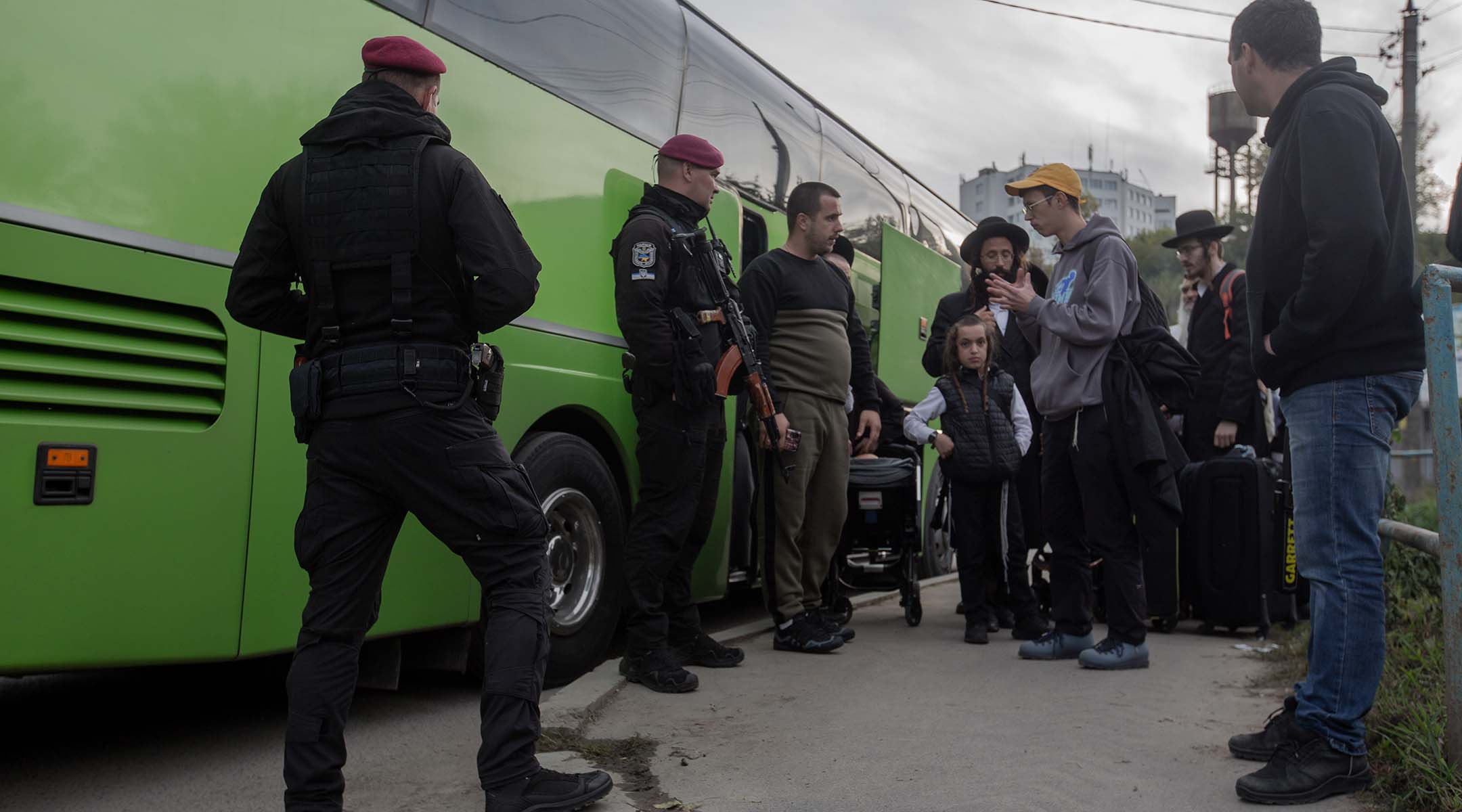
The
town has upped its police presence as the pilgrims continue to make
their way in
“I haven’t seen anyone come to
explain anything yet,” says Bernard, 25, from Borough Park in Brooklyn.
Men pushed past him in a hallway inside the grave complex to collect
their coats and hats after morning prayers had finished. “I don’t think
that they need to come and explain anything anyway.”
“The war is eight hours away from
here,” he added, referring to the fact that Ukrainians are currently in
the middle of a successful operation to push the Russians back to the
east. “In Israel, everyone lives much closer to the areas where the
missiles fall from Syria or from Gaza than here.”
There is also a perception that the
past two pilgrimages, which took place during the start of and then a
year into the COVID-19 pandemic, had prepared many for the logistical
difficulties of getting to Ukraine in a crisis.
“We all came early last year because
of COVID,” said Bernard. “They wanted to close the borders, so everyone
came early. We came months before, two years ago, when corona started.”
Despite the enthusiasm of those who
have made the trek, the overall number of pilgrims is way down. In 2018,
when 40,000 Jews filled every available bed — from hotel suites to
hostels in damp Khrushchev-era apartment buildings — Mikhail Pinto was
charging $5,000 for four days in one of his rooms in the large hotel he
owns on Pushkin Street, the main drag that runs through the Jewish
quarter. This year, that rate is down to $1,000.
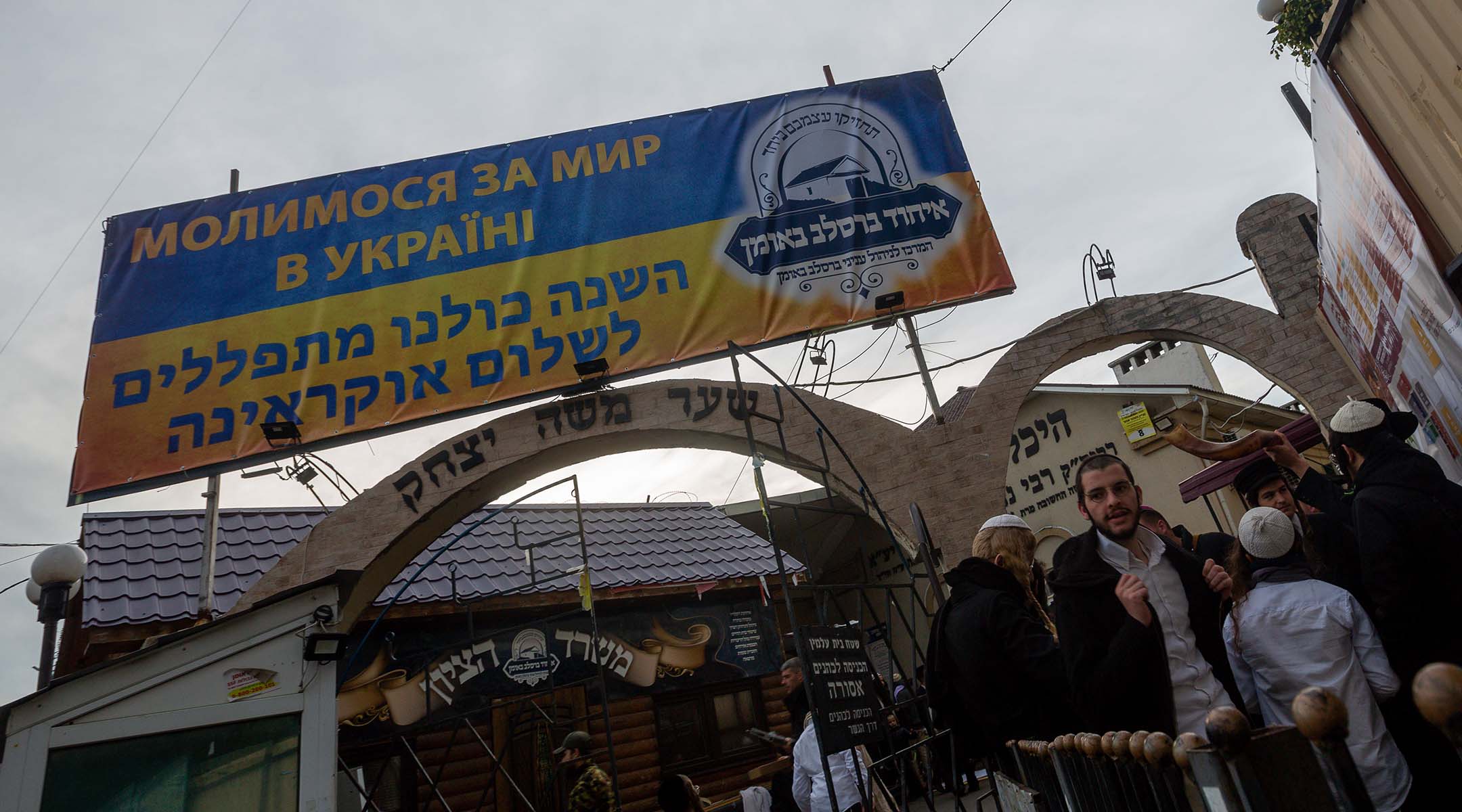
A
banner reads “We are praying for peace in Ukraine”
He has noticed a steep drop in people coming from New York specifically.
“Americans and Canadians … they can’t
get the proper insurance,” he said. “For Israelis, this isn’t so much
of a big deal, but for Americans, it has been a huge issue.”
Overcoming obstacles to the
pilgrimage has become ingrained in the collective myth of those who come
to Uman. During the 1930s, when access to Uman was strictly forbidden
to Jewish pilgrims, they secretly visited apartments near the cemetery
where Rabbi Nachman was buried under the threat of arrest and
deportation to Siberia. The Soviet Union then tried to stamp out the
pilgrimage as part of its atheist agenda, but by the late 1940s
officials relented to allow tiny numbers of closely watched Soviet Jews
make the trip.
It was not until the Soviet Union
began to liberalize under Mikhail Gorbachev that it began to reopen
access to Uman for the vast majority of Breslov followers who lived in
Israel and the United States. In 1988, some 250 visas to visit Uman were
granted.
This year, both Ukrainian and Israeli
officials are clearly frustrated at the steadfast insistence among many
Israelis, who make up roughly 90% of those who make the pilgrimage to
Ukraine. The Israeli government has opened discussions with some Breslov
leaders to encourage them to take a clear stance against coming, but
officials have clearly been disappointed with the response, as few have
chosen to echo these messages with any urgency internally.
Many pilgrims have also already run
afoul of the wartime restrictions that are in place across Ukraine. In
Ternopil, in western Ukraine, a group of pilgrims were arrested after
hanging around and taking photos of a Ukrainian military checkpoint.
Many others have been stopped for not taking the strict curfew
restrictions seriously.
“It is dangerous. It is a risk. There
is nothing that we or the Ukrainians can do to help protect you,” said
Michael Brodsky, Israel’s ambassador to Ukraine. “The Ukrainians are
using all of their efforts to fight the war and they don’t have the
bandwidth to deal with the problems of tourists coming.”











